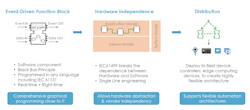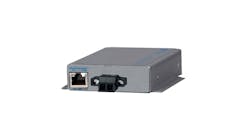Sometimes the best fix for a new problem is an old standby that's been available for a long time, but wasn't used much because it was ahead of its time and hadn't found the right challenge yet. This is how a 16-year-old reference architecture of the IEC 61499 standard is enabling interoperability today.
But first, a little background: process industry end users have long sought plug-and-play automation and controls that will free them from the rigid and proprietary technologies of the past. Several strategies were launched and are being tested, such as the Open Process Automation Standard (O-PAS) from Open Process Automation Forum, and Module Type Package from NAMUR. However, because interoperability and open networking aren't restricted to any single method, these two plug-and-play solutions will likely be joined by others.
Dusting off IEC 61499
In fact, a third effort has been underway since mid-November, when several organizations formed UniversalAutomation.org (UAO), an independent, not-for-profit, non-competitive association to manage a shared-source, runtime, reference architecture of the IEC 61499 standard. Published in 2005, IEC 61499 addresses function blocks for industrial process measurement and control systems, and defines a generic model for DCSs. It was produced by IEC that developed IEC 61131 for PLCs.
"IEC 61499 was available for years, but it wasn't used. It specifies a generic, event-driven automation architecture, which lets hardware-independent software components be plugged together to create an application," says John Conway, president of UAO. "This lets the software run on any IEC 61499-compliant hardware, and be distributed to the broader architecture."
More recently, Austria-based nxtControl developed runtime software based on IEC 61499 and IEC 61131 that runs in controllers. It was acquired by Schneider Electric in 2017, which has supplied software for O-PAS testbeds, and plans to distribute it via a shared-source approach.
Figure 1: To overcome proprietary roadblocks and lacking portability in process controls, UniversalAuotomation.org (UAO) decouples software and hardware with a reference implementation of the IEC 61499 standard, and establishes a supplier-agnostic environment of portable, interoperable, plug-and-play software that can function with almost any device. Source: UAO
Widening appeal
By decoupling software and hardware, and sharing a reference implementation of IEC 61499, UAO's members will use it to build new automation types. The organization plans to establish a supplier-agnostic environment of portable, interoperable, plug-and-play software that can work with almost any device (Figure 1).
"This software was provided to UAO using a shared-source approach, and its members will manage the reference implementation," explains Conway. "This will give users portable code and hardware-independent software. Suppliers will add the runtime software to their hardware. In the past, each supplier's proprietary software would only run in their devices, and they didn't work will with IT. We're trying to change this, so users can run proven-in-use software on any device, and better coordinate real-time control with applications like analytics, simulation, etc."
Members of UniversalAutomation.org include: Aalto University, Actemium, Advantech, Asus, Belden, Cargill, Dynamic Process, eaw Relaistechnik GmbH, ESA, ETP, Flexbridge, gr3n, Hirschmann, HTW Berlin, Intel, Jetter, Johannes Kepler University Linz, Kongsberg Maritime, Luleå University of Technology, Lumberg Automation, Phoenix Contact, ProSoft, R. Stahl, Schneider Electric, Shell, VP Process, Wilo, wood and Yokogawa.
Because the organization is recruiting new members, others are expected to join soon. They'll jointly develop and adopt next-generation universal automation solutions by collectively incrementing the runtime following shared-source principles. Members will have access and the ability to shape the future of automation. "If a supplier wants to participate, we'll explain the UAO approach, and do a technical workshop on their technology platform," says Greg Boucaud, CMO of UAO. "Then they can evaluate and decide if they want to sign up."
Blocks, models and libraries
Because its software and reference architecture can run on any IEC 61499-compliant hardware, UAO runtime can serve as an execution engine for creating libraries of function blocks and information models that can run on IEC 61499 devices (Figure 2).
Figure 2: UAO is enabled by IEC 61499 that covers function blocks for industrial process measurement and control systems, defines a generic model for DCSs, and is based on IEC 61131 standard for programmable controllers. This lets UAO's software run on any IEC 61499-compliant hardware, and be distributed to the broader architecture. Source: UAO
"This is like downloading an app for a smart phone or implementing Linux software. You don't need to know everything about the standard; you just join and use the software," says Boucaud. "Likewise, we don't need to promote the standard. We just promote the software and reference architecture, and their interoperability, portability and reusability, along with the plug-and-produce and object-oriented IT and operations technology (OT) capabilities they provide."
Conway adds, “This effort is complementary to what O-PAS and MTP are trying to achieve. Think of it as a technology enabler to make it easier to implement these standards using a proven-in-use software component approach.”
Beyond the reusable software UAO provides, Conway reports IEC 61499 is enabling other software development programs, such as Eclipse 4diac (www.eclipse.org/4diac), which is an open-source PLC framework for distributed process measurement and controls. 4diac includes development and runtime environments, function block library and example projects. 4diac also uses IEC 61499 for improving software encapsulation for reusability, which provides a vendor-independent format and simplifies support for controller communications. Conway adds discussions are ongoing between the two initiatives.
"One of the best advantages of reusable software and interoperability is that far more people and organizations can use these solutions, which would otherwise take years to develop independently," says Conway. "Promoting interoperability with UAO lets us say 'let's all use the same runtime engine and reference implementation,' and invite everyone to join. This allows everyone to overcome former proprietary obstacles together."
Conway reports the true worth of UAO isn't in its runtime code or that it lets controllers from different manufacturers talk to each other. "It's value is in what a plug-and-produce approach can add to users' process controls, operations, productivity and products," adds Conway. "This is why its members are willing to share some significant intellectual property to develop UAO, answer questions about it, build trust, and help it reach critical mass, where it can really begin to make a difference. In the end, users benefit from the increased innovation at lower cost using proven-in-use application software, while the suppliers benefit from a growing marking for the software components."
Reusable software for PET recycling
Conway concludes that UAO is already being incorporated into some products designed and produced by its members, such as Schneider Electric's EcoStruxure Automation Expert software. Likewise, several users are integrating UAO software and devices into their processes.
For example, gr3n S.A. (gr3n-recycling.com) in Chiasso, Switzerland, is using UAO to help control microwave-assisted reactors it operates as part of its chemical process for decomposing and recycling PET plastics. It uses different types of depolymerization to break down polymers in waste PET, regain the same quality as virgin PET, and convert it into useful chemicals such as oligomers and monomers. At its two-year-old, modular demonstration plant in Chieti, Italy, gr3n employs an alkaline hydrolysis process that usually takes three to five hours at 210-250 °C, but is improved by its core reactor to produce terephthalic acid (TPA) and monoethylene glycol (MEG) from discarded bottles and textiles in less than 10 minutes at less than 200 °C.
"Our demo plant consists of modular units that are a natural fit for using UAO for real-time control of its six or seven PLCs, distributing control functions to them, and integrating HMIs with object-oriented programming," says Franco Cavadini, CTO at gr3n. "Our five major units include the core reactor that uses microwaves to accelerate the hydrolysis reaction and make it economical, pumping and filtering to purify the TPA, distillation, secondary purification of one the two monomers, and crystallization into the final product."
Cavadini adds that gr4n's demo plant has an annual capacity of 500-1,000 tonnes per year, but it's planning to scale up to full-size plants that will be 10-20 times bigger with capacities of about 30,000 tonnes per year. The demo was built by gr3n and its joint venture partner NextChem (nextchem.it), which is the green chemistry and energy transition subsidiary of Maire Tecnimont in Milan, Italy.
"Our demo plant is small, so if we used traditional controls, it wouldn't make that much of a difference," explains Cavadini. "However, for us, UAO is an investment in the future because we can reuse our code in subsequent modular plants, just like reusing any object-oriented software. If we didn't have UAO, our plant and equipment would still be modular, but our software wouldn't be modular, and we'd have to rewrite about 80% of it each time we build a new plant. With UAO, we can reuse 80-85% of our code. Plus, using UAO to decouple software from hardware will also make it easer to maintain and update existing processes and facilities, and give us the flexibility to select the most suitable PLCs and HMIs for each site."








